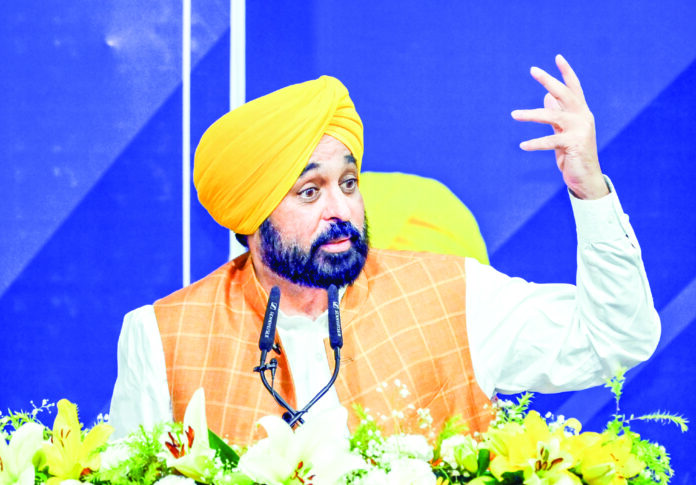
Mann leverages Bhakra water dispute to boost pro-farmer image amid criticism
CHANDIGARH: Caught on sticky ground, Punjab Chief Minister Bhagwant Mann has attempted to transform the Bhakra water dispute with Haryana into a potent political tool to strengthen his profarmer image and deflect criticism over governance lapses.
The Mann-led AAP government in Punjab has faced severe criticism from farmers for using police force against protesting farmers at the Shambhu and Khanauri borders. But Mann’s move to curtail Haryana’s water share from the Bhakra Dam, terming it a “loot on Punjab’s water,” has not only helped counter the backlash over police crackdowns on farmer protests but also secured the backing of the Samyukta Kisan Morcha (SKM), which opposed the BJPled Union government’s decision to deploy CISF at Bhakra Dam.
Even the Bhakra Beas Management Board (BBMB) attempted to restore Haryana’s water supply to its legitimate right of 8,500 cusecs. But Mann seized the moment by openly challenging the directive, asserting that Haryana had already exceeded its annual water quota by 103% by March 31, well before the May 21 deadline.
Claiming that Punjab was already grappling with its own water scarcity, Mann declared that no surplus water was available. Moreover, amid reports of an imminent water release to Haryana during BBMB Chairman Manoj Tripathi’s visit, Mann boosted deployments at the dam and symbolically locked the dam gates. After this three-week political drama at Bhakra Dam, the Mann government celebrated the move as “Fateh Diwas” on May 21 and organised a “Victory Day” rally.
Mann, who himself led the protest at the dam along with his ministers, positioned himself as a protector of Punjab’s water resources. He used this opportunity to target the BJP-led governments at the Centre and Haryana, accusing them of “institutional bullying” and “vendetta politics.”
According to political observers, by locking the dam gates, holding protests, and increasing deployments, Mann managed to channel farmers’ frustration against the BJP-led Centre and tried to tilt rural sentiment in his favour by projecting himself as the staunch defender of Punjab’s water rights.
Politically, the move helped him counter the increasing presence of Haryana Chief Minister Nayab Singh Saini in Punjab, as Saini had made several visits to Punjab in the past couple of months and even promised guaranteed Minimum Support Price (MSP) to Punjab farmers on the lines of Haryana if the BJP came to power in 2027.
However, the Union government tried to handle the situation carefully, but the deployment of 296 Central Industrial Security Force (CISF) personnel at Bhakra and Nangal dams, at a cost of over Rs 8.58 crore, provided Mann another opportunity to rally support. He criticised the move as unnecessary, emphasising that Punjab Police had secured the dams for decades without additional expense.
This stance earned him the support of the Samyukta Kisan Morcha, which had earlier criticised the Mann government for using police force to remove protesting farmers from the Haryana and Punjab borders. In a statement, the SKM, which includes a majority of farmer leaders from Punjab and Haryana, condemned the Centre’s decision and extended support to Mann’s actions. An in-depth analysis of Mann’s focus on the canal water dispute reveals that with this move, he tried to strike a chord with Punjab’s agrarian communities, where over 80% of farmland depends on canal and groundwater irrigation.
By prioritising water flow to the “tails” of irrigation channels, Mann addressed a critical concern for farmers facing depleting groundwater levels. “Punjabis have proved that if the state can protect the borders of the country, they can aptly save the waters of the state too,” he said at the Nangal rally, attempting to build a narrative of ‘Kisan and Jawan’ to project himself as a defender of rural interests.
He further contrasted his proactive stance with the perceived inaction of previous Congress and Akali Dal governments, enhancing his credibility among farmers. Mann faced intense scrutiny for his government’s crackdown on farmer protests, particularly the detention of Sanyukt Kisan Morcha (Non-Political) and Kisan Mazdoor Morcha leaders, including Jagjit Singh Dallewal, in early May.
The heavy barricading at Shambhu and accusations of turning Punjab into a “garrison state” threatened to erode his agrarian base. But it is now believed that the water campaign also served as a strategic shield against mounting criticism of the AAP government in Punjab, as he questioned the silence of farmer unions during the BBMB standoff, subtly shifting blame and reinforcing his role as the primary advocate for Punjab’s water rights.
Mann not only called a special one-day session of the state Assembly over this issue but also held an allparty meeting to win support from opposition party leaders on this sensitive matter. He used the water dispute to counter criticism from opposition parties over the Amritsar hooch tragedy, which claimed 21 lives.
Opposition leaders like Partap Singh Bajwa and Manjinder Singh Sirsa blamed Mann’s excise policies, but Mann continued to focus on his aggressive water advocacy to divert attention. By offering Rs 10 lakh compensation per family and promising jobs, Mann tried to mitigate some damage, but it was his water narrative that dominated public discourse, framing the Centre and Haryana as adversaries in Punjab’s long-standing water-sharing grievances, particularly the Sutlej-Yamuna Link (SYL) canal issue. Ignoring severe criticism from the Supreme Court over the SYL water controversy, Mann proposed a Yamuna-Sutlej Link (YSL) canal, flipping the SYL controversy to assert Punjab’s claim over Yamuna waters.
This, along with his call for BBMB’s reconstitution, bolstered his regionalist credentials and resonated with Punjab’s agrarian ethos. The Punjab and Haryana High Court’s May 15 directive seeking stakeholder responses on the BBMB issue was touted by Mann government as a “moral victory,” further solidifying his narrative of standing up for Punjab. “Politically, Mann’s water offensive has yielded significant gains.
The SKM’s support and the enthusiastic response from rural voters have strengthened his position ahead of future elections,” said political analyst Advocate Kamal Anand, adding that by tapping into Punjab’s deep-seated water-sharing grievances, Mann has deflected criticism over governance failures and positioned AAP as the primary defender of agrarian interests.
However, refusing to bear the CISF deployment cost may also strain relations with the Centre, complicating the situation further. For now, Mann’s strategic use of the Bhakra water dispute has provided a powerful tool for AAP leadership in the state. But it will be crucial to see whether the Bhakra water dispute helps him sail through anti-incumbency and retain ground in the farmersdominated rural areas of Punjab.







